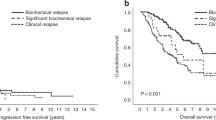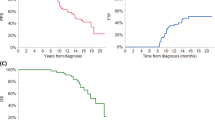Abstract
The achievement of CR is the crucial step for a prolonged PFS and OS after an autologous SCT in multiple myeloma (MM). Unfortunately, even with the use of new regimens and the current high CR rates, most, if not all, patients will ultimately relapse or progress. We analyzed the type of relapse or progression (asymptomatic vs symptomatic), clinical features including the presence of extramedullary involvement and time to next treatment in 211 patients who underwent melphalan-based autologous SCT over an 18-year period at our institution. After autologous SCT, serological or asymptomatic relapse/progression was observed in about one half of the patients. The treatment-free interval was significantly longer in patients relapsing from CR than in those progressing from PR (P=0.017). Patients with serological relapse/progression had a significantly longer OS than those relapsing from symptomatic disease (P=0.002). The relapse pattern was similar to the initial clinical presentation. Survival after relapse/progression was shorter in those patients with a 24-h urine M-protein excretion of at least 200 mg (P=0.048). Extramedullary involvement was frequent (24%), being the highest risk in patients with extramedullary involvement at diagnosis (P=0.001).
This is a preview of subscription content, access via your institution
Access options
Subscribe to this journal
Receive 12 print issues and online access
$259.00 per year
only $21.58 per issue
Buy this article
- Purchase on Springer Link
- Instant access to full article PDF
Prices may be subject to local taxes which are calculated during checkout


Similar content being viewed by others
References
Kyle RA, Rajkumar SV . Criteria for diagnosis, staging, risk stratification and response assessment of multiple myeloma. Leukemia 2009; 23: 3–9.
Bladé J, Rosiñol L, Cibeira MT, Rovira M, Carreras E . Hematopoietic stem cell transplantation for multiple myeloma beyond 2010. Blood 2010; 115: 3655–3663.
Kumar SK, Rajkumar SV, Dispenzieri A, Lacy MQ, Hayman SR, Buadi FK et al. Improved survival in multiple myeloma and the impact of novel therapies. Blood 2008; 111: 2516–2520.
Nadal E, Giné E, Bladé J, Esteve J, Rosiñol L, Fernández-Avilés F et al. High-dose therapy/autologous stem cell transplantation in patients with chemosensitive myeloma: predictors of complete remission. Bone Marrow Transplant 2004; 33: 61–64.
Dingli D, Pacheco JM, Dispenzieri A, Hayman SR, Kumar SK, Lacy MQ et al. Serum M-spike and transplant outcome in patients with multiple myeloma. Cancer Sci 2007; 98: 1035–1040.
Martinez-Lopez J, Blade J, Mateos MV, Grande C, Alegre A, García-Laraña J et al. Long-term prognostic significance of response in multiple myeloma after stem cell transplantation. Blood 2011; 118: 529–534.
Alegre A, Granda A, Martínez-Chamorro C, Díaz-Mediavilla J, Martínez R, García-Laraña J et al. Different patterns of relapse after autologous peripheral blood stem cell transplantation inmultiple myeloma: clinical results of 280 cases from the Spanish Registry. Haematologica 2002; 87: 609–614.
Rajkumar SV, Harousseau JL, Durie B, Anderson KC, Dimopoulos M, Kyle R et al. Consensus recommendations for the uniform reporting of clinical trials: report of the International Myeloma Workshop Consensus Panel 1. Blood 2011; 117: 4691–4695.
Bladé J, Fernández de Larrea C, Rosiñol L, Cibeira MT, Jiménez R, Powles R . Soft-tissue plasmacytomas in multiple myeloma: incidence, mechanisms of extramedullary spread, and treatment approach. J Clin Oncol 2011; 29: 3805–3812.
Bladé J, Samson D, Reece D, Apperley J, Björkstrand B, Gahrton G et al. Criteria for evaluating disease response and progression in patients with multiple myeloma treated by high-dose therapy and haemopoietic stem cell transplantation. Myeloma Subcommittee of the EBMT: European Group for Blood and Marrow Transplant. Br J Haematol 1998; 102: 1115–1123.
Alexanian R, Weber D, Delasalle K, Handy B, Champlin R, Giralt S . Clinical outcomes with intensive therapy for patients with primary resistant multiple myeloma. Bone Marrow Transplant 2004; 34: 229–234.
Alexanian R, Weber D, Giralt S, Dimopoulos M, Delasalle K, Smith T et al. Impact of complete remission with intensive therapy in patients with responsive multiple myeloma. Bone Marrow Transplant 2001; 27: 1037–1043.
Brenner H, Gondos A, Pulte D . Recent major improvement in long-term survival of younger patients with multiple myeloma. Blood 2008; 111: 2521–2526.
Rosiñol L, Oriol A, Teruel AI, Hernández D, López-Jiménez J, de la Rubia J et al. Superiority of bortezomib, thalidomide, and dexamethasone (VTD) as induction pretransplantation therapy in multiple myeloma: a randomized phase 3 PETHEMA/GEM study. Blood 2012; 120: 1589–1596.
Badros AZ . Lenalidomide in myeloma-a high-maintenance friend. N Engl J Med 2012; 366: 1836–1838.
Sanfructuoso C, Caballero MD, Garcia-Sanz R, Vidriales B, Vazquez L, San Miguel JF . Relapse of multiple myeloma in extramedullary sites after autologous bone marrow transplantation. Eur J Haematol 1996; 56: 181–183.
Dawson MA, Patil S, Spencer A . Extramedullary relapse of multiple myeloma associated with a shift in secretion from intact immunoglobulin to light chains. Haematologica 2007; 92: 143–144.
Zamarin D, Giralt S, Landau H, Lendvai N, Lesokhin A, Chung D et al. Patterns of relapse and progression in multiple myeloma patients after autoSCT: implications for patients monitoring after transplantation. Bone Marrow Transplant 2013; 48: 419–424.
Varettoni M, Corso A, Pica G, Mangiacavalli S, Pascutto C, Lazzarino M . Incidence, presenting features and outcome of extramedullary disease in multiple myeloma: a longitudinal study on 1003 consecutive patients. Ann Oncol 2009; 21: 325–330.
Lenhoff S, Hjorth M, Turesson I, Westin J, Gimsing P, Wislöff F et al. Intensive therapy for multiple myeloma in patients younger than 60 years. Long-term results focusing on the effect of the degree of response on survival and relapse pattern after transplantation. Haematologica 2006; 91: 1228–1233.
Zeiser R, Deschler B, Bertz H, Finke J, Engelhardt M . Extramedullary vs medullary relapse after autologous or allogeneic hematopoietic stem cell transplantation (HSCT) in multiple myeloma (MM) and its correlation to clinical outcome. Bone Marrow Transplant 2004; 34: 1057–1065.
Wu P, Davies F, Boyd K, Thomas K, Dines S, Saso RM et al. The impact of extramedullary disease at presentation in the outcome of myeloma. Leuk Lymphoma 2009; 50: 230–235.
Rajkumar SV, Merlini G, San Miguel JF . Haematological cancer: redefining myeloma. Nat Rev Clin Oncol 2012; 9: 494–496.
Acknowledgements
We would like to thank Esther Bladé for her technical support in this research. This work has been supported in part by grants RD12/0036/0046 and PI12/1093 from the Instituto de Salud Carlos III and ‘Josep Font’ Grant from Hospital Clínic de Barcelona.
Author information
Authors and Affiliations
Corresponding author
Ethics declarations
Competing interests
JB received honoraria from lectures and the Advisory Board of Janssen and Celgene, as well as grant support from Janssen. The remaining authors declare no conflict of interest.
Additional information
Author contributions
CFL and JB designed the study, collected and analyzed the data, performed the assays and statistical analysis, wrote and reviewed the paper; RJ, LR, EG, NT, MTC, FFA, CM and MR treated the patients, collected data and reviewed the paper.
Rights and permissions
About this article
Cite this article
Fernández de Larrea, C., Jiménez, R., Rosiñol, L. et al. Pattern of relapse and progression after autologous SCT as upfront treatment for multiple myeloma. Bone Marrow Transplant 49, 223–227 (2014). https://doi.org/10.1038/bmt.2013.150
Received:
Revised:
Accepted:
Published:
Issue Date:
DOI: https://doi.org/10.1038/bmt.2013.150
Keywords
This article is cited by
-
Optimal timing of treatment at relapse after autologous stem cell transplantation in patients with multiple myeloma: a study of the Korean Multiple Myeloma Working Party (KMM-1909)
Bone Marrow Transplantation (2022)
-
Relapse with plasmacytoma after upfront autologous stem cell transplantation in multiple myeloma
Annals of Hematology (2022)
-
Relapsed refractory multiple myeloma: a comprehensive overview
Leukemia (2019)
-
Expert Panel Consensus Statement for Proper Evaluation of First Relapse in Multiple Myeloma
Current Hematologic Malignancy Reports (2019)
-
Myeloid transformation of plasma cell myeloma: molecular evidence of clonal evolution revealed by next generation sequencing
Diagnostic Pathology (2018)



